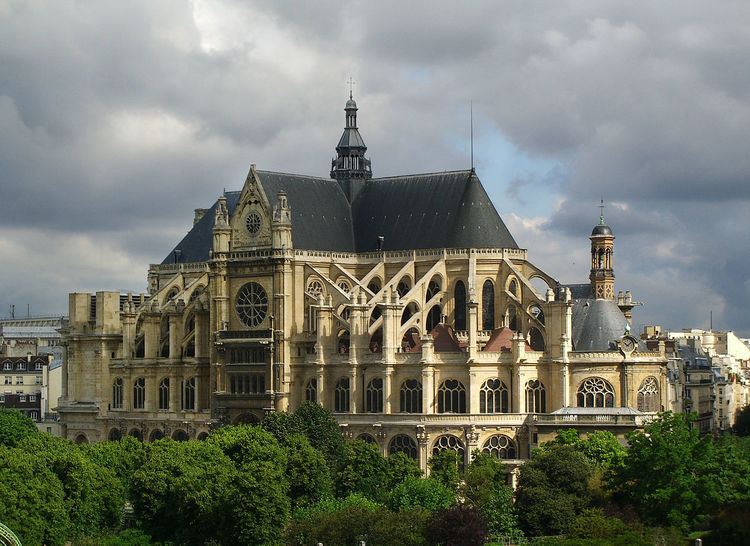Region Île-de-France | Opened 1633 | |
 | ||
Location 2 Impasse Saint-Eustache, 1 arr. Address 2 Impasse Saint-Eustache, 75001 Paris, France Similar Les Halles, Church of Saint‑Sulpice - Paris, La Madeleine - Paris, Saint‑Germain l'Auxerrois, Saint‑Jacques Tower Profiles | ||
The Church of St Eustache, Paris (French: L’église Saint-Eustache) is a church in the 1st arrondissement of Paris. The present building was built between 1532 and 1632.
Contents
Situated at the entrance to Paris' ancient markets (Les Halles) and the beginning of rue Montorgueil, St Eustace's is considered a masterpiece of late Gothic architecture. The church’s reputation was strong enough at the time for it to be chosen as the location for a young Louis XIV to receive communion. Mozart also chose the sanctuary as the location for his mother’s funeral. Among those baptised here as children were Richelieu, Jeanne-Antoinette Poisson, future Madame de Pompadour and Molière, who was also married here in the 17th century. The last rites for Anne of Austria, Turenne and Mirabeau were pronounced within its walls. Marie de Gournay is buried there.
History
Situated in Les Halles, an area of Paris once renowned for fresh produce of all kinds, the origins of Saint Eustache date back to the 13th century. The church became a parish church in 1223, thanks to a man named Jean Alais who achieved this by taxing the baskets of fish sold nearby, as granted by King Philip Augustus. To thank such divine generosity, Alais constructed a chapel dedicated to Sainte-Agnès, a Roman martyr. The construction of the current church began in 1532, the work not being finally completed until 1637. The name of the church refers to Saint Eustace, a Roman general of the second century AD who was burned, along with his family, for converting to Christianity, and it is believed that it was the transfer of a relic of Saint Eustache from the Abbey to Saint-Denis to the Church of Saint Eustache which resulted in its naming. Jeanne Baptiste d'Albert de Luynes was baptised here.
According to tourist literature on-site, during the French Revolution the church, like most churches in Paris, was desecrated, looted, and used for a time as a barn. The church was restored after the Revolution had run its course and remains in use today. Several impressive paintings by Rubens remain in the church today. Each summer, organ concerts commemorate the premieres of Berlioz’s Te Deum and Liszt’s Christus here in 1886.
Description
The church is an example of a Gothic structure clothed in Renaissance detail. Although the architects are unknown, similarities to designs used in the extension of the church of Saint-Maclou in Pontoise (begun in 1525) point to Jean Delamarre and/or Pierre Le Mercier, who collaborated in that work. The Italian-born architect Domenico da Cortona has also been suggested. The church is relatively short in length at 105m, but its interior is 33.45m high to the vaulting. At the main façade, the left tower has been completed in Renaissance style, while the right tower remains a stump. The front and rear aspects provide a remarkable contrast between the comparatively sober classical front and the exuberant rear, which integrates Gothic forms and organization with Classical details. The L'écoute sculpture by Henri de Miller appears outside the church, to the south. A Keith Haring sculpture stands in a chapel of the church.
Chapel of the Virgin
The Chapel of the Virgin was built in 1640 and restored from 1801 to 1804. It was inaugurated by Pius VII on the 22nd of December, 1804 when he came to Paris for the coronation of Napoleon.
The apse chapel, with a ribbed cul-de-four vault, has at its centre a sculpture of the Virgin and Child of Jean-Baptiste Pigalle that the painter Thomas Couture highlighted by three large paintings on the themes:
Organ
With 8,000 pipes, the organ is reputed to be the largest pipe organ in France, surpassing the organs of Saint Sulpice and Notre Dame de Paris. The organ originally constructed by P.-A. Ducroquet was powerful enough for the premiere of Hector Berlioz's titanic Te Deum to be performed at St-Eustache in 1855. It was later modified under the direction of Joseph Bonnet. The present organ of St. Eustache was designed by Jean-Louis Coignet under the direction of Titular Organist Jean Guillou and dates from 1989 when it was almost entirely rebuilt by Dutch firm Van Den Heuvel, retaining a few ranks of pipes from the former organ and the wooden buffet, which is original.
